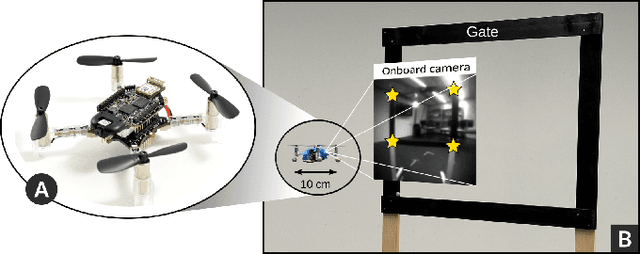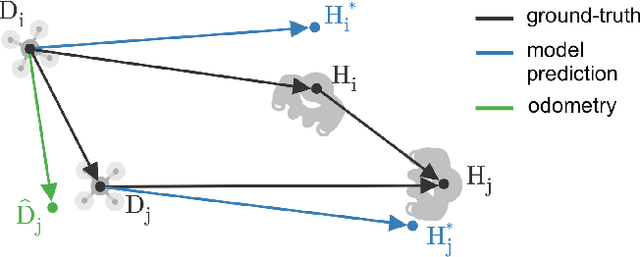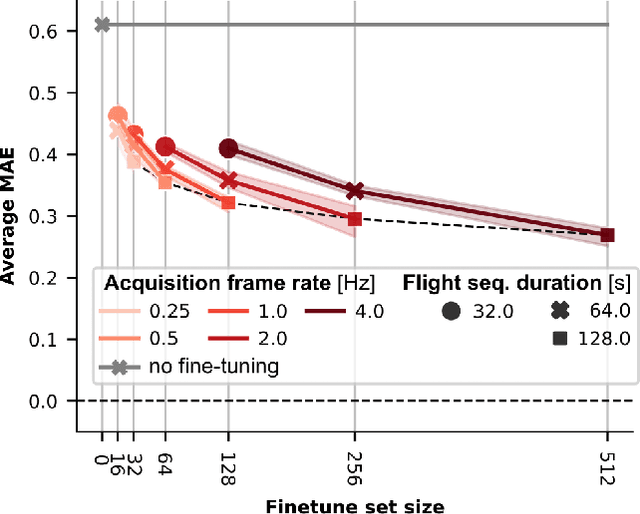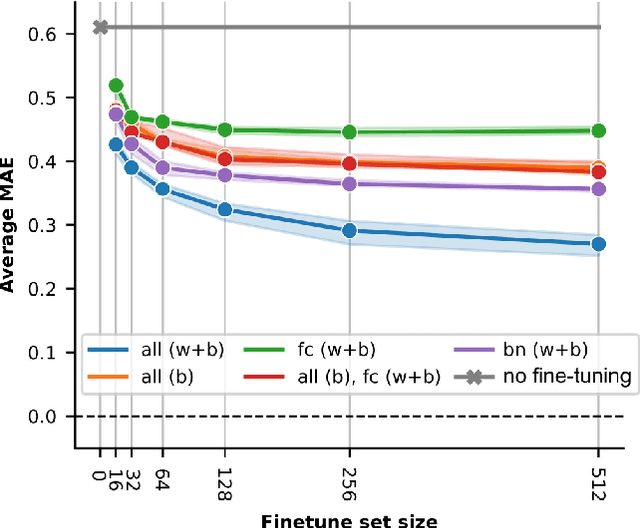Daniele Palossi
Dalle Molle Institute for Artificial Intelligence, Integrated Systems Laboratory
A Map-free Deep Learning-based Framework for Gate-to-Gate Monocular Visual Navigation aboard Miniaturized Aerial Vehicles
Mar 07, 2025



Abstract:Palm-sized autonomous nano-drones, i.e., sub-50g in weight, recently entered the drone racing scenario, where they are tasked to avoid obstacles and navigate as fast as possible through gates. However, in contrast with their bigger counterparts, i.e., kg-scale drones, nano-drones expose three orders of magnitude less onboard memory and compute power, demanding more efficient and lightweight vision-based pipelines to win the race. This work presents a map-free vision-based (using only a monocular camera) autonomous nano-drone that combines a real-time deep learning gate detection front-end with a classic yet elegant and effective visual servoing control back-end, only relying on onboard resources. Starting from two state-of-the-art tiny deep learning models, we adapt them for our specific task, and after a mixed simulator-real-world training, we integrate and deploy them aboard our nano-drone. Our best-performing pipeline costs of only 24M multiply-accumulate operations per frame, resulting in a closed-loop control performance of 30 Hz, while achieving a gate detection root mean square error of 1.4 pixels, on our ~20k real-world image dataset. In-field experiments highlight the capability of our nano-drone to successfully navigate through 15 gates in 4 min, never crashing and covering a total travel distance of ~100m, with a peak flight speed of 1.9 m/s. Finally, to stress the generalization capability of our system, we also test it in a never-seen-before environment, where it navigates through gates for more than 4 min.
An Efficient Ground-aerial Transportation System for Pest Control Enabled by AI-based Autonomous Nano-UAVs
Feb 20, 2025Abstract:Efficient crop production requires early detection of pest outbreaks and timely treatments; we consider a solution based on a fleet of multiple autonomous miniaturized unmanned aerial vehicles (nano-UAVs) to visually detect pests and a single slower heavy vehicle that visits the detected outbreaks to deliver treatments. To cope with the extreme limitations aboard nano-UAVs, e.g., low-resolution sensors and sub-100 mW computational power budget, we design, fine-tune, and optimize a tiny image-based convolutional neural network (CNN) for pest detection. Despite the small size of our CNN (i.e., 0.58 GOps/inference), on our dataset, it scores a mean average precision (mAP) of 0.79 in detecting harmful bugs, i.e., 14% lower mAP but 32x fewer operations than the best-performing CNN in the literature. Our CNN runs in real-time at 6.8 frame/s, requiring 33 mW on a GWT GAP9 System-on-Chip aboard a Crazyflie nano-UAV. Then, to cope with in-field unexpected obstacles, we leverage a global+local path planner based on the A* algorithm. The global path planner determines the best route for the nano-UAV to sweep the entire area, while the local one runs up to 50 Hz aboard our nano-UAV and prevents collision by adjusting the short-distance path. Finally, we demonstrate with in-simulator experiments that once a 25 nano-UAVs fleet has combed a 200x200 m vineyard, collected information can be used to plan the best path for the tractor, visiting all and only required hotspots. In this scenario, our efficient transportation system, compared to a traditional single-ground vehicle performing both inspection and treatment, can save up to 20 h working time.
Accelerating Image-based Pest Detection on a Heterogeneous Multi-core Microcontroller
Aug 29, 2024Abstract:The codling moth pest poses a significant threat to global crop production, with potential losses of up to 80% in apple orchards. Special camera-based sensor nodes are deployed in the field to record and transmit images of trapped insects to monitor the presence of the pest. This paper investigates the embedding of computer vision algorithms in the sensor node using a novel State-of-the-Art Microcontroller Unit (MCU), the GreenWaves Technologies' GAP9 System-on-Chip, which combines 10 RISC-V general purposes cores with a convolution hardware accelerator. We compare the performance of a lightweight Viola-Jones detector algorithm with a Convolutional Neural Network (CNN), MobileNetV3-SSDLite, trained for the pest detection task. On two datasets that differentiate for the distance between the camera sensor and the pest targets, the CNN generalizes better than the other method and achieves a detection accuracy between 83% and 72%. Thanks to the GAP9's CNN accelerator, the CNN inference task takes only 147 ms to process a 320$\times$240 image. Compared to the GAP8 MCU, which only relies on general-purpose cores for processing, we achieved 9.5$\times$ faster inference speed. When running on a 1000 mAh battery at 3.7 V, the estimated lifetime is approximately 199 days, processing an image every 30 seconds. Our study demonstrates that the novel heterogeneous MCU can perform end-to-end CNN inference with an energy consumption of just 4.85 mJ, matching the efficiency of the simpler Viola-Jones algorithm and offering power consumption up to 15$\times$ lower than previous methods. Code at: https://github.com/Bomps4/TAFE_Pest_Detection
Training on the Fly: On-device Self-supervised Learning aboard Nano-drones within 20 mW
Aug 06, 2024



Abstract:Miniaturized cyber-physical systems (CPSes) powered by tiny machine learning (TinyML), such as nano-drones, are becoming an increasingly attractive technology. Their small form factor (i.e., ~10cm diameter) ensures vast applicability, ranging from the exploration of narrow disaster scenarios to safe human-robot interaction. Simple electronics make these CPSes inexpensive, but strongly limit the computational, memory, and sensing resources available on board. In real-world applications, these limitations are further exacerbated by domain shift. This fundamental machine learning problem implies that model perception performance drops when moving from the training domain to a different deployment one. To cope with and mitigate this general problem, we present a novel on-device fine-tuning approach that relies only on the limited ultra-low power resources available aboard nano-drones. Then, to overcome the lack of ground-truth training labels aboard our CPS, we also employ a self-supervised method based on ego-motion consistency. Albeit our work builds on top of a specific real-world vision-based human pose estimation task, it is widely applicable for many embedded TinyML use cases. Our 512-image on-device training procedure is fully deployed aboard an ultra-low power GWT GAP9 System-on-Chip and requires only 1MB of memory while consuming as low as 19mW or running in just 510ms (at 38mW). Finally, we demonstrate the benefits of our on-device learning approach by field-testing our closed-loop CPS, showing a reduction in horizontal position error of up to 26% vs. a non-fine-tuned state-of-the-art baseline. In the most challenging never-seen-before environment, our on-device learning procedure makes the difference between succeeding or failing the mission.
Distilling Tiny and Ultra-fast Deep Neural Networks for Autonomous Navigation on Nano-UAVs
Jul 17, 2024Abstract:Nano-sized unmanned aerial vehicles (UAVs) are ideal candidates for flying Internet-of-Things smart sensors to collect information in narrow spaces. This requires ultra-fast navigation under very tight memory/computation constraints. The PULP-Dronet convolutional neural network (CNN) enables autonomous navigation running aboard a nano-UAV at 19 frame/s, at the cost of a large memory footprint of 320 kB -- and with drone control in complex scenarios hindered by the disjoint training of collision avoidance and steering capabilities. In this work, we distill a novel family of CNNs with better capabilities than PULP-Dronet, but memory footprint reduced by up to 168x (down to 2.9 kB), achieving an inference rate of up to 139 frame/s; we collect a new open-source unified collision/steering 66 k images dataset for more robust navigation; and we perform a thorough in-field analysis of both PULP-Dronet and our tiny CNNs running on a commercially available nano-UAV. Our tiniest CNN, called Tiny-PULP-Dronet v3, navigates with a 100% success rate a challenging and never-seen-before path, composed of a narrow obstacle-populated corridor and a 180{\deg} turn, at a maximum target speed of 0.5 m/s. In the same scenario, the SoA PULP-Dronet consistently fails despite having 168x more parameters.
Tiny-PULP-Dronets: Squeezing Neural Networks for Faster and Lighter Inference on Multi-Tasking Autonomous Nano-Drones
Jul 02, 2024Abstract:Pocket-sized autonomous nano-drones can revolutionize many robotic use cases, such as visual inspection in narrow, constrained spaces, and ensure safer human-robot interaction due to their tiny form factor and weight -- i.e., tens of grams. This compelling vision is challenged by the high level of intelligence needed aboard, which clashes against the limited computational and storage resources available on PULP (parallel-ultra-low-power) MCU class navigation and mission controllers that can be hosted aboard. This work moves from PULP-Dronet, a State-of-the-Art convolutional neural network for autonomous navigation on nano-drones. We introduce Tiny-PULP-Dronet: a novel methodology to squeeze by more than one order of magnitude model size (50x fewer parameters), and number of operations (27x less multiply-and-accumulate) required to run inference with similar flight performance as PULP-Dronet. This massive reduction paves the way towards affordable multi-tasking on nano-drones, a fundamental requirement for achieving high-level intelligence.
Multi-resolution Rescored ByteTrack for Video Object Detection on Ultra-low-power Embedded Systems
Apr 17, 2024



Abstract:This paper introduces Multi-Resolution Rescored Byte-Track (MR2-ByteTrack), a novel video object detection framework for ultra-low-power embedded processors. This method reduces the average compute load of an off-the-shelf Deep Neural Network (DNN) based object detector by up to 2.25$\times$ by alternating the processing of high-resolution images (320$\times$320 pixels) with multiple down-sized frames (192$\times$192 pixels). To tackle the accuracy degradation due to the reduced image input size, MR2-ByteTrack correlates the output detections over time using the ByteTrack tracker and corrects potential misclassification using a novel probabilistic Rescore algorithm. By interleaving two down-sized images for every high-resolution one as the input of different state-of-the-art DNN object detectors with our MR2-ByteTrack, we demonstrate an average accuracy increase of 2.16% and a latency reduction of 43% on the GAP9 microcontroller compared to a baseline frame-by-frame inference scheme using exclusively full-resolution images. Code available at: https://github.com/Bomps4/Multi_Resolution_Rescored_ByteTrack
Fusing Multi-sensor Input with State Information on TinyML Brains for Autonomous Nano-drones
Apr 03, 2024Abstract:Autonomous nano-drones (~10 cm in diameter), thanks to their ultra-low power TinyML-based brains, are capable of coping with real-world environments. However, due to their simplified sensors and compute units, they are still far from the sense-and-act capabilities shown in their bigger counterparts. This system paper presents a novel deep learning-based pipeline that fuses multi-sensorial input (i.e., low-resolution images and 8x8 depth map) with the robot's state information to tackle a human pose estimation task. Thanks to our design, the proposed system -- trained in simulation and tested on a real-world dataset -- improves a state-unaware State-of-the-Art baseline by increasing the R^2 regression metric up to 0.10 on the distance's prediction.
On-device Self-supervised Learning of Visual Perception Tasks aboard Hardware-limited Nano-quadrotors
Mar 06, 2024



Abstract:Sub-\SI{50}{\gram} nano-drones are gaining momentum in both academia and industry. Their most compelling applications rely on onboard deep learning models for perception despite severe hardware constraints (\ie sub-\SI{100}{\milli\watt} processor). When deployed in unknown environments not represented in the training data, these models often underperform due to domain shift. To cope with this fundamental problem, we propose, for the first time, on-device learning aboard nano-drones, where the first part of the in-field mission is dedicated to self-supervised fine-tuning of a pre-trained convolutional neural network (CNN). Leveraging a real-world vision-based regression task, we thoroughly explore performance-cost trade-offs of the fine-tuning phase along three axes: \textit{i}) dataset size (more data increases the regression performance but requires more memory and longer computation); \textit{ii}) methodologies (\eg fine-tuning all model parameters vs. only a subset); and \textit{iii}) self-supervision strategy. Our approach demonstrates an improvement in mean absolute error up to 30\% compared to the pre-trained baseline, requiring only \SI{22}{\second} fine-tuning on an ultra-low-power GWT GAP9 System-on-Chip. Addressing the domain shift problem via on-device learning aboard nano-drones not only marks a novel result for hardware-limited robots but lays the ground for more general advancements for the entire robotics community.
High-throughput Visual Nano-drone to Nano-drone Relative Localization using Onboard Fully Convolutional Networks
Feb 21, 2024Abstract:Relative drone-to-drone localization is a fundamental building block for any swarm operations. We address this task in the context of miniaturized nano-drones, i.e., 10cm in diameter, which show an ever-growing interest due to novel use cases enabled by their reduced form factor. The price for their versatility comes with limited onboard resources, i.e., sensors, processing units, and memory, which limits the complexity of the onboard algorithms. A traditional solution to overcome these limitations is represented by lightweight deep learning models directly deployed aboard nano-drones. This work tackles the challenging relative pose estimation between nano-drones using only a gray-scale low-resolution camera and an ultra-low-power System-on-Chip (SoC) hosted onboard. We present a vertically integrated system based on a novel vision-based fully convolutional neural network (FCNN), which runs at 39Hz within 101mW onboard a Crazyflie nano-drone extended with the GWT GAP8 SoC. We compare our FCNN against three State-of-the-Art (SoA) systems. Considering the best-performing SoA approach, our model results in an R-squared improvement from 32 to 47% on the horizontal image coordinate and from 18 to 55% on the vertical image coordinate, on a real-world dataset of 30k images. Finally, our in-field tests show a reduction of the average tracking error of 37% compared to a previous SoA work and an endurance performance up to the entire battery lifetime of 4 minutes.
 Add to Chrome
Add to Chrome Add to Firefox
Add to Firefox Add to Edge
Add to Edge